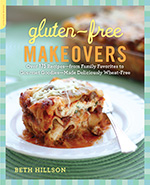Baking Basics
FOOD IS CONNECTION
“A dish, a smell, a sizzle, transports me back to a delicious memory and I want to go there again. But what if it’s gluten-filled? No problem. I make it over – – gluten-free – – and I’m transported all the way,” says baking expert, Beth Hillson.
…
Do you hunger for the foods you left behind and thought you could never eat again? I’ll show you how to bring back the dishes you’ve been missing and make them safe for your special diet.
Want help making over a favorite recipe? Send it to me at beth@glutenfreemakeovers.com I will publish the recipe here and show you how I did it.
My Philosophy on Gluten-Free Baking
(1) Any recipe can be made gluten-free. Replace the offending ingredients with ingredients that are safe for your diet.
Flour is usually a one-for-one substitution except for bread baking which defies all principals of food chemistry. More about gluten-free breads below.
Use a blend of gluten-free flours to replicate the properties of the dish – – light flours and a small amount of gum for cakes and cookies; high protein flours and extra gum for breads, pie crusts and pizza.
(2) Making over gluten-filled recipes is to fill your tummy with happiness.
Never underestimate the smile that comes from biting into a birthday cake that has your name written on the frosting.
(3) Eating well is the best way to avoid cheating on your diet.
Cravings make us do foolish things, things we might regret before the last bite has been devoured. Make it gluten-free and you’ll enjoy every last morsel.
(4) Gluten-y is its own reward
A Good Blend is a Great Thing
Finding a blend with protein, fiber and elasticity produces light-textured baked goods with wonderful mouthfeel. Once you have found blends that you like, you can replace regular flour, cup-for-cup with successful results.
Principles of a Successful Recipe Makeover
A recipe’s DNA is based on the ratio of flour to sugar, fat and liquids, wet to dry. This determines the final product.
As you look at the formula think about the anticipated taste and texture. Will it have the fine crumb and delicate texture of a cake or cupcake, the chewy mouthfeel of a dense bread, the
flakiness of a pie crust? This will help determine the right type of blend. More about blends below.
If you maintain that ratio, nearly every recipe can be recreated gluten free. Imagine cutting a recipe in half. That means every ingredient in that recipe must be cut in half to maintain the integrity of the final product. It’s the same idea when you want to maintain the ratios, the balance in any recipe.
Applying the balance of ingredients and using a good blend of flours will soon have you baking your way back to the tasty treats you thought were not possible in a gluten-free world.
The Blends – – Another Balancing Act
One kind of gluten-free flour alone will produce a gritty, heavy, unappealing baked good. But combine a blend of flours like rice flour, sorghum flour, potato starch, tapioca starch, xanthan gum and salt, and you’ll have a pleasant-tasting base to replace regular flour.
To create the formula: Use no more than 30% of each flour and roughly 20% of each starch for a total of 100%.
Tips for creating a blend
Every gluten-free flour and starch has different characteristics. You can replace one flour with another, keeping in mind that you don’t want to use more than 30% of any one flour.
If the texture of the baked products is too gummy, you probably have too much starch in your blend. Tapioca starch, in particular, produces dense baked goods. Cornstarch produces a light texture, but too much can create a dry and crumbly product.
Include a flour with protein in your blend. Protein helps replace the elasticity in gluten. Among the flours with lots of protein are:
Amaranth
Buckwheat
Chickpea
Corn flour
Oat flour
Sorghum flour
About Gums
Vary the amount of gum depending on the final product.
For yeast breads, pizza and pie crust – 1 teaspoon xanthan or guar gum per cup of flour blend.
For cakes and cupcakes and cookies – ½ teaspoon gum per cup of flour blend.
For muffins and quick breads – ½ to ¾ teaspoon gum per cup of flour blend.
Once you have success with a blend, mix up large batches and store in tightly sealed plastic bags in the refrigerator. (There are a zillion commercial brands today as well and one of those will work, too.)
Measuring Flour
Whether you are measuring flour to make a blend or measuring a blend to use in a recipe, spoon the ingredients into the measuring cup and level with the back of a knife. Using the measuring cup as a scoop can pack a lot more flour into your recipe and alter the taste and texture.
SELF-RISING FLOUR
reprinted with permission from Gluten-Free Makeovers (Da Capo Press, Oct 2011)
Mix up a big batch and store in the refrigerator. Use for muffin, quick bread and pancake recipes.
1¼ cups white rice flour (6.5 ounces)
1 cup sweet white sorghum flour (4 ounces)
¾ cup amaranth flour (3 ounces)
¾ cup cornstarch (3.5 ounces) or potato starch (4 ounces)
¼ cup tapioca starch/flour (1.1 ounces)
2 tablespoons baking powder
2 teaspoons xanthan gum
1½ teaspoons salt







 Baking guru,
Baking guru,